Fluid Dynamics summary
Fluid Dynamics summary
Fluid Dynamics
- All athletic events take place in a fluid environment
- water (swimming), air (cycling), both (water polo)
-
- Drag and lift forces are perpendicular to each other, produce different effects, and are affected by different factors
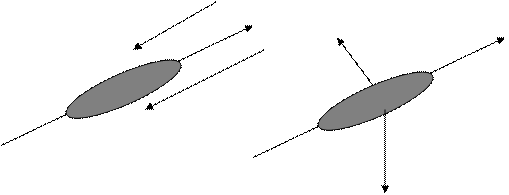
Fluid Drag Forces
- Both skin friction and profile drag are proportional to relative flow velocity, cross-sectional area, shape of object, smoothness of surface, and density of liquid
Skin Friction Drag
- Caused by the fluid tending to rub (shear) along the surface of the body
-
- The layer of fluid next to the skin sticks to the body; however, the next layer is towed along and therefore slides relative to the innermost layer
-
-
-
Laminar flow
- The smooth, layered, flow pattern of a fluid around an object with no disturbance
-
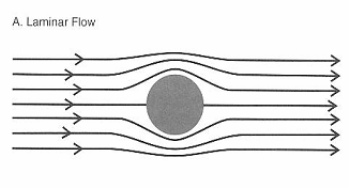
Profile Drag
- The main form of drag in skiing, cycling, running , all projectiles events, and swimming
-
- Characterized by turbulent flow in which the pressure on the leading surface of a body is greater than the pressure on the trailing surface
Turbulent flow
- This causes a large, turbulent, low-pressure zone to form behind the object
- The region of low pressure increases the amount of work done on the object
-
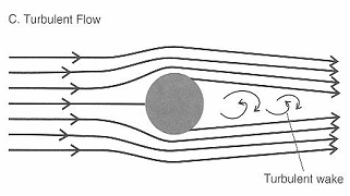
Fluid Lift Forces
- Always directed perpendicular to the flow velocity
-
- More air flows over the upper curved surface than the lower flat surface, such that the difference in velocity across the surfaces results in a pressure difference between the two sides
- The external force resulting from the pressure difference is perpendicular to the direction of flow velocity, and can change the motion of the object
- Bernoulli’s principle –
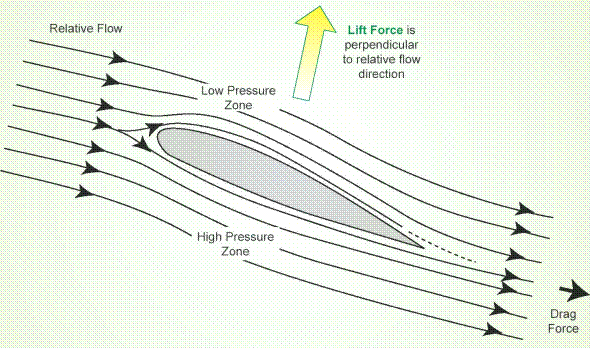
Angle of Attack
- Refers to the tilt of an object relativeto the flow velocity
-
- Function of the shape of an object and the flow velocity
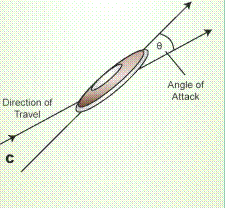
If the angle of attack increases too much, it approaches a critical maximum angle (stall angle), beyond which the lift force decreases as the drag force becomes dominant
The Magnus Effect
- The changes in flight path are always perpendicular to the flow velocity of the projectile
Why a Curveball Curves (topspin, under spin, sidespin)
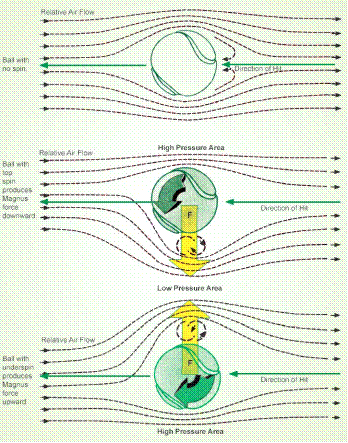
Body Balance and Stability Control
-
- Generally depends upon the location of the centre of mass and how stable that centre of mass is
- The stick figure model is useful
Equilibrium
- The state of a system that is not experiencing any change in its direction or speed
- Static Equilibrium:
- Dynamic Equilibrium:
Balance
- Process whereby the body’s state of equilibrium is controlled for a given purpose
-
- If the line of gravity passes through some part of the body’s base of support, the body will be balanced
Stability
- A measure of the difficulty with which equilibrium can be disturbed
-
- There is a trade-off between maximizing stability and acquiring speed off a mark
Increasing Stability in Static Equilibrium
-
- Increase the inertia of the body
-
- Increase the distance between the point where a vertical line from the centre of mass intersects the base of support
Increasing Stability in Dynamic Equilibrium
- Enlarge the body’s base of support in the direction of the external horizontal forces
- Adopt a starting position in which the centre of pressure is close to the edge of the base of support whenever a quick acceleration is important
- When slowing down or reversing directions in running, lean backwards but keep normal frictional forces high to prevent slipping
-
Source: http://www.dpcdsb.org/NR/rdonlyres/BB1CF9BA-5940-4CBF-A562-ACF4181E6853/106220/OH5FluidDynamicsstudent.doc
Web site to visit: http://www.dpcdsb.org/
Author of the text: not indicated on the source document of the above text
If you are the author of the text above and you not agree to share your knowledge for teaching, research, scholarship (for fair use as indicated in the United States copyrigh low) please send us an e-mail and we will remove your text quickly.
Fair use is a limitation and exception to the exclusive right granted by copyright law to the author of a creative work. In United States copyright law, fair use is a doctrine that permits limited use of copyrighted material without acquiring permission from the rights holders. Examples of fair use include commentary, search engines, criticism, news reporting, research, teaching, library archiving and scholarship. It provides for the legal, unlicensed citation or incorporation of copyrighted material in another author's work under a four-factor balancing test. (source: http://en.wikipedia.org/wiki/Fair_use)
The information of medicine and health contained in the site are of a general nature and purpose which is purely informative and for this reason may not replace in any case, the council of a doctor or a qualified entity legally to the profession.
Fluid Dynamics summary
Fluid Dynamics summary
The following texts are the property of their respective authors and we thank them for giving us the opportunity to share for free to students, teachers and users of the Web their texts will used only for illustrative educational and scientific purposes only.
All the information in our site are given for nonprofit educational purposes
The information of medicine and health contained in the site are of a general nature and purpose which is purely informative and for this reason may not replace in any case, the council of a doctor or a qualified entity legally to the profession.
Fluid Dynamics summary
www.riassuntini.com





